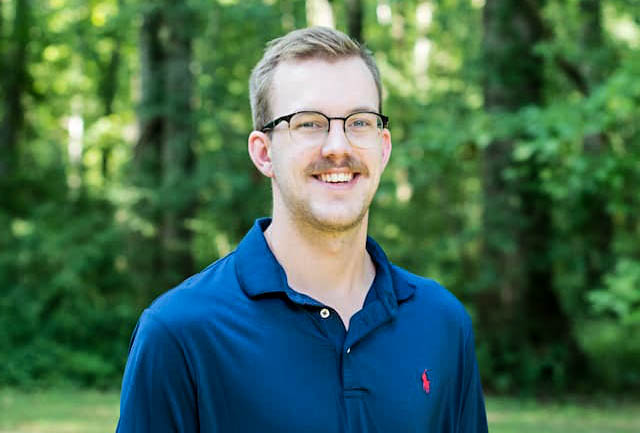
Samford University chemistry and math alumnus Robert Houston Givhan '22 is one step closer to his dream of working for NASA. He is currently pursuing his Ph.D. in computational physical chemistry at the University of Georgia, an accomplishment he says would not have been possible without his involvement in the Department of Chemistry and Biochemistry's faculty-guided research program at Samford.
“I would not be at Georgia if it were not for the Samford Chemistry Department,” Givhan said. “My extended time in the research lab gave me the opportunity to interact with professors, investigate the world and find what interested me.”
Initially a pre-med student, Givhan decided to change paths and pursue chemistry for his bachelor’s degree at Samford. During that time is when he joined the research program.
"I wanted to boost my resume and get hands-on experience to improve my worth as a scientist and become a well-rounded student," Givhan said.
“Our undergraduates are not merely observing professors as they run instruments and perform experiments,” Chemistry and Biochemistry Associate Professor Corey Johnson said. “They are trained to be experimental scientists themselves. They work directly with our faculty to design, run and interpret experiments.”
Givhan started working with Johnson during his sophomore year in 2019 until he graduated in 2022.
“Samford is a small school, and we often get to work directly with students for multiple years,” Johnson said. “We get to see them mature in their understanding and develop as scientists, critical thinkers and problem solvers. As a faculty member, it is a thrill to open the doors and watch the lights come on.”
"I had a wonderful experience in the program," Givhan said. "Professor Johnson is a wonderful scientist and person. He was a mentor and friend who helped me progress in my scientific career in and outside the laboratory. In recalling my memories at Samford, some of my best experiences had been doing research with him."
Johnson's research focuses on protein enzymatics with a special interest in small laccase (SLAC), a protein that acts as an enzyme. Givhan was responsible for improving the purification process and preparing ligands for binding in a joint project with Chemistry and Biochemistry Professor Brian Gregory.
"I focused on the purification process to improve the concentration and lifetime of SLAC and mass spectrometry to determine the binding efficiency with pegylation," Givhan said.
Gathering results would be no small feat. With the Covid pandemic running rampant across the U.S., it made it nearly impossible for Givhan, Gregory and Johnson to make progress.
"We kept hitting a lot of barriers," Givhan said. "Research came to an almost dead halt in the spring of my sophomore year and fall of my junior year.
However, in the summer of his junior year, that all changed.
"We were able to discover our issues with the protein purification process," Givhan said. "We were able to increase protein stability, concentration and volume through the process. We were able to analyze it on the mass-spec and investigate the binding efficiency with polyethylene glycols to see its potential use."
“Houston was a critical component in the research activities emanating from Dr. Johnson’s research group,” Gregory said. “In fact, most of our interesting samples of PEGylated enzymes were synthesized by him. “
By the end of the process, Givhan not only became a well-rounded student and scientist, but he also received guidance on where to go next.
"Professor Johnson helped me figure out the pros and cons of graduate school and where it could lead," Givhan said. "He was a vital part of my growth as a scientist. Professor Gregory was also a wonderful instructor that taught me many useful tools and applications.
They also helped him narrow down a career path that was right for him.
"I knew by the end of my degree that I wanted to get a Ph.D. in chemistry, and I did not want to work in a wet lab," Givhan said. "I loved math and physical chemistry."
Former Chemistry and Biochemistry Chair Morgan Ponder’s relationship with Givhan's current lab director, Henry Schaefer, is how he ended up at the University of Georgia.
"Professor Ponder worked with Professor Schaefer,” Givhan said. "Gregory also had students who went to Georgia, and they were able to talk to me about their experience. The other faculty, Professor Pursell, Garza, Wilger and Wiget, all gave me helpful advice about graduate school and taught me a lot about their fields and career paths."
Givhan is currently studying electron interactions in molecular systems to elucidate their properties. Something he hopes will ultimately prepare him for his dream job.
"My goal is to work for NASA to study the chemistry of the Interstellar Medium (ISM)," Givhan said. "I have a specific interest in molecules of Astro biological importance and understanding their behavior and formation in the ISM."
“Houston is a very intelligent, talented guy,” Johnson said. “It was great to have him in the lab for an extended period. He became a veteran in my lab and helped me train other students. We are all proud of his success and I know he will continue to excel in graduate school.”
Learn more about the Department of Chemistry and Biochemistry's research program.
Support the next generation of scientists with a donation.
